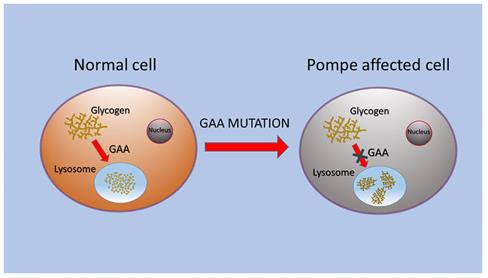What is GAA Protein
The glycogen-degrading enzyme, officially known as acid alpha-glucosidase (GAA), plays a pivotal role in cellular processes. Synonyms for this crucial protein include acid maltase and alpha-1,4-glucosidase. GAA belongs to the glycoside hydrolase family 31 and is a lysosomal enzyme responsible for breaking down glycogen into glucose. Recent advances in research have shed light on the structural characteristics and classification of GAA, opening new avenues for understanding its multifaceted functions.
GAA Biological Functions and Molecular Mechanisms
The biological functions of GAA are intricately linked to its role in glycogen metabolism. Within lysosomes, GAA catalyzes the hydrolysis of glycogen, releasing glucose into the cytoplasm. This process is crucial for maintaining glucose homeostasis and providing energy to cells. The molecular mechanisms behind GAA's action involve its interaction with lysosomal targeting signals and the formation of enzyme-substrate complexes. These mechanisms are central to cellular health, emphasizing the significance of GAA in maintaining metabolic equilibrium.

Figure 1. Schematic representation of GAA alteration that caused glycogen storage in lysosomes of PD cells. (Taverna S, et al., 2020)
GAA Related Signaling Pathway
The signal pathway associated with GAA involves a complex interplay of cellular components. GAA is synthesized in the endoplasmic reticulum, undergoes post-translational modifications in the Golgi apparatus, and is ultimately targeted to lysosomes. The intricate trafficking of GAA is orchestrated by signals that guide its proper localization. Dysregulation in this pathway can lead to compromised GAA function, contributing to the development of Pompe disease. Understanding the signal pathway of GAA provides valuable insights into potential therapeutic interventions for disorders associated with its malfunction.
GAA Related Diseases
While GAA is indispensable for normal cellular function, mutations in the gene encoding this enzyme can lead to severe health consequences. Pompe disease, a rare autosomal recessive disorder, is characterized by a deficiency of GAA, resulting in the accumulation of glycogen within lysosomes. This glycogen storage disorder primarily affects muscles and can manifest as muscle weakness, respiratory problems, and cardiac issues. Pompe disease underscores the critical role of GAA in preventing pathological glycogen buildup and maintaining cellular health.
GAA's Applications in Biomedicine
Beyond its fundamental role in cellular function, GAA has found applications in various biomedical fields, driving advancements in diagnostics, vaccine development, and therapeutics.
- Diagnostic Development: GAA's involvement in Pompe disease has made it a key target for diagnostic assays. Detection of GAA activity or genetic mutations associated with Pompe disease aids in early diagnosis, enabling timely intervention and management. Diagnostic tools leveraging GAA contribute to improved patient outcomes and enhanced understanding of glycogen storage disorders.
- Vaccine Development: The unique immunogenic properties of GAA have spurred interest in its potential for vaccine development. Researchers are exploring the use of GAA as an antigen to stimulate immune responses, offering a promising avenue for developing vaccines against infectious diseases or conditions involving aberrant glycogen metabolism.
- Therapeutics: The therapeutic potential of GAA extends to enzyme replacement therapy (ERT) for Pompe disease. ERT involves administering exogenous GAA to patients to compensate for the deficient enzyme, mitigating the pathological effects of glycogen accumulation. Ongoing research aims to optimize ERT strategies, enhancing the efficacy and accessibility of treatment for individuals affected by Pompe disease.
Recommended Products
| Cat.No. | Product Name | Species | Source (Host) | Tag |
|---|---|---|---|---|
| GAA-002H | Active Recombinant Human Acid α-glucosidase (GAA) | Human | HEK293T | His |
| GAA-173H | Active Recombinant Human GAA protein, His-tagged | Human | HEK293 | His |
| GAA-177H | Recombinant Human GAA protein, MYC/DDK-tagged | Human | HEK293 | Myc/DDK |
| GAA-176H | Recombinant Human GAA protein, MYC/DDK-tagged | Human | HEK293 | Myc/DDK |
| GAA-175H | Recombinant Human GAA protein, MYC/DDK-tagged | Human | HEK293 | Myc/DDK |
| GAA-28090TH | Recombinant Human GAA protein, GST-tagged | Human | Wheat Germ | GST |
| GAA-160H | Recombinant Human GAA Protein, His-tagged | Human | E.coli | His |
| GAA-159H | Recombinant Human GAA Protein, His-tagged | Human | E.coli | His |
| GAA-28087TH | Recombinant Human GAA | Human | Wheat Germ | N/A |
| GAA-3385H | Recombinant Human GAA Protein, Myc/DDK-tagged, C13 and N15-labeled | Human | HEK293T | Myc/DDK |
Reference
- Taverna S, et al. Pompe disease: pathogenesis, molecular genetics and diagnosis. Aging (Albany NY). 2020, 12(15): 15856.

